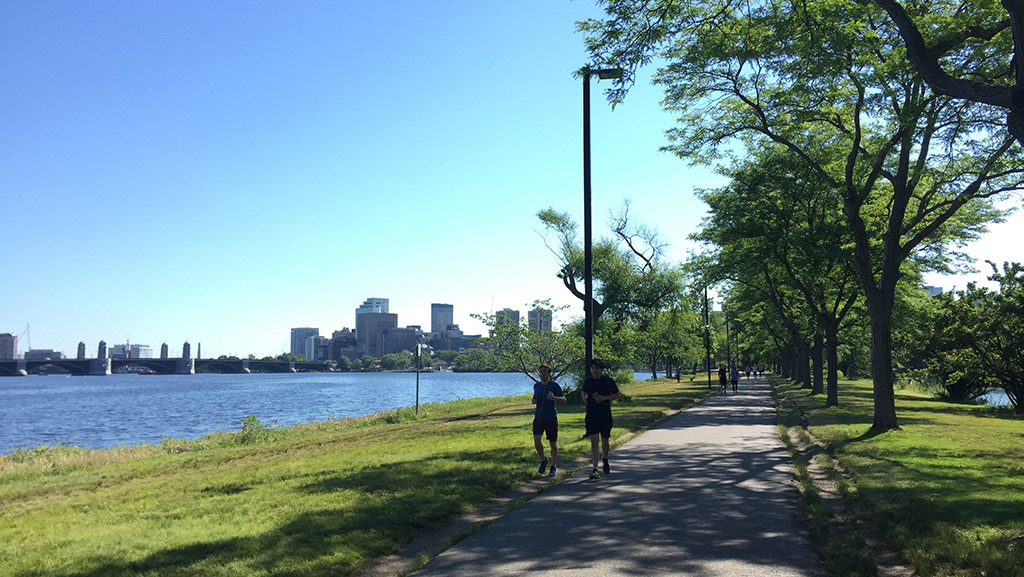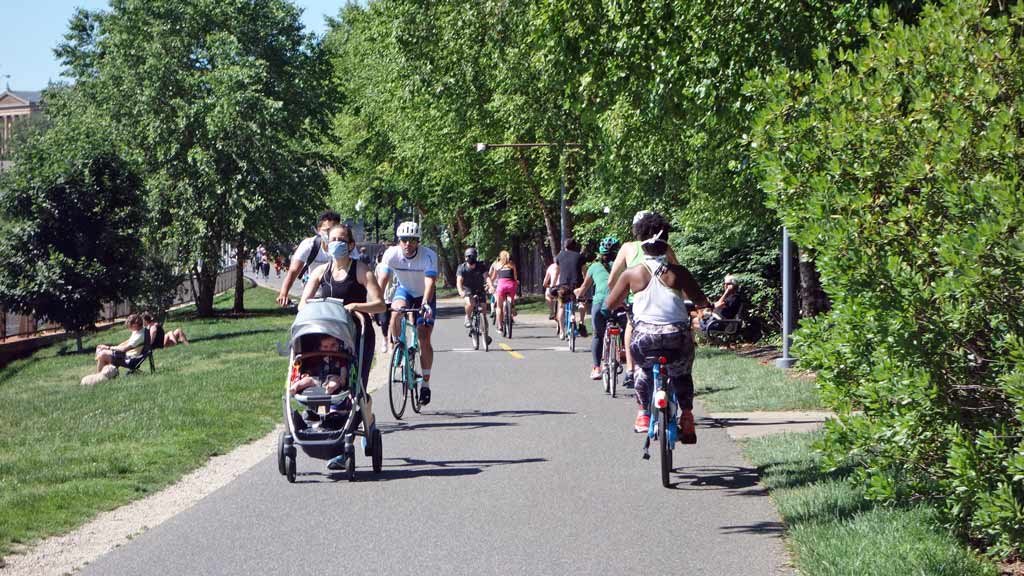The idea started with eight dreamy-eyed biking enthusiasts: Wouldn’t it be cool to pedal from Maine to Florida on protected trails, away from major highways and roads? And what if pedestrians, runners and others could also use portions of the route to exercise, explore nature or commute without a car?
So began an ambitious plan to develop the East Coast Greenway, a biking and walking route to connect 15 states and 450 communities along 3,000 miles. “They were thinking about connecting cities,” says Brandon Douglass, a board member of the nonprofit East Coast Greenway Alliance, an REI partner. “Instead of just putting a path in the woods, like the Appalachian Trail, they wanted to do something that really brought cities together.”
REI Cooperative Action Fund
The East Coast Greenway Alliance is a grantee partner of the REI Cooperative Action Fund, which directly supports organizations promoting justice, equity and belonging in the outdoors. Other partners include the Washington Area Bicyclist Association in support of the Capital Trails Coalition, the Great River Passage Conservancy in support of East Side River District Project and the San Francisco Parks Alliance in support of the Blue Greenway project. Learn more and donate at REIFund.org.
Thirty years later, more than 1,000 miles of off-road trail have been completed. Most of it is paved to be accessible to people with disabilities. Some segments ribbon urban waterfronts, like the Hudson River in Manhattan. Other dirt or gravel paths bring users through natural areas, including wildlife refuges, urban parks and country fields.

Dozens of miles of new trail are added each year. But the ECG, as locals call it, still has a long way to go to stitch together a seamless off-road route. Currently, one-third of the 3,000-mile route is protected from car traffic. But the effort is already a success: An estimated 50 million people visited the trail last year. That’s more than last year’s total visits to the top 10 national parks. (A few people have even walked the entire length).
“We’re building something at people’s doorsteps,” says Dennis Markatos-Soriano, executive director of the ECG, an REI partner. He adds, “It’s our job to bring parks and the outdoors to people where they live so they can build a lifestyle that’s both healthy and sustainable at the same time.”
A growing trend
The ECG is one of many efforts underway to increase access to outdoor spaces and recreation opportunities, particularly in underserved communities. The Capital Trails Coalition (CTC) is working to create an interconnected network of multi-use trails in the Washington D.C. metropolitan area. In Saint Paul, Minnesota, the Great River Passage Conservancy supports projects that connect residents to the Mississippi River. And the Blue Greenway project is developing 13 miles of parks and trails along San Francisco’s southeastern waterfront and providing green spaces for the city’s most underserved neighborhoods. Meanwhile, Friends of the Los Angeles River has a dual goal to ensure equitable public access to and ecological restoration of the city’s waterway.
These projects, and many others, have been in the works for years. But as people have turned to the outdoors during the COVID-19 pandemic, access to these natural spaces is more vital than ever. They’re “a haven of health and a sanctuary of sanity,” Markatos-Soriano says, noting the ECG saw a 50% increase in use over the past 18 months. He adds that the benefits of these green spaces will long outlive COVID-19. “They’re also essential for us moving forward as we tackle the climate crisis and as we try to make sure that we’re building equitable public space for everyone—every color and every economic circumstance—to enjoy.”
Improving equitable access
Indeed, too often green spaces are built first and most frequently in affluent, often white neighborhoods. Communities of color are three times more likely than white communities to live in nature-deprived areas, according to a 2020 report. The Capital Trails Coalition recognizes “longstanding and current social inequities” and is working to promote equitable trail development. For instance, after analyzing factors like the needs of low-income communities and communities of color, the organization prioritized 40 projects that would provide more than 230,000 people (nearly 75% of whom identify as people of color) access to trails within 1 mile of their homes.
By prioritizing those trail segments, “the CTC hopes to expand trail access to communities where transportation planners, agencies and advocates have historically underinvested time and resources,” says Stephanie Piperno, trails coalition manager at the Washington Area Bicyclist Association. The group is part of the CTC and an REI partner.

These greenways also offer a safe and inexpensive to get outside and exercise. Connecting pathways and parks—and thereby making them viable options for commuting—will likewise allow users to get their heart rate up while getting where they need to go, advocates say.
That also translates to transportation and environmental benefits. Each time someone bikes or walks to work or the store instead of driving, they’re reducing carbon emissions and traffic congestion. Those trips add up. Trips on these greenways can reduce greenhouse gas emissions, as seen in a 2018 study. Vancouver, B.C., residents who used the local greenway generated 21% less travel-related emissions a day than they had before the path was in place.
“Trails are not just an amenity,” Piperno says. “They are people’s primary modes of transportation and main tool for recreation in many cases.”
These biking and walking trails are essential infrastructure projects worth investing in, says Markatos-Soriano. The East Coast Greenway Alliance, along with more than 200 active transportation advocacy organizations, has urged federal leaders to allocate $10 billion of a proposed infrastructure plan for multi-use trail projects across the country. Under that legislative umbrella sits the bipartisan Connecting America’s Active Transportation System Act, which reserves $2.5 billion to develop safe and connected biking and walking trails.
In August, the Senate passed a version of the so-called American Jobs Plan that included trail projects. The bill establishes the grant program envisioned in the Connecting America’s Active Transportation System Act but does not provide funding. Advocates hope a version of the grant program will pass the Senate this fall.
Economic, environmental benefits
They have economic data on their side. The trails are expensive to build (though far less costly than roads and highways, Piperno points out). Yet studies repeatedly show they nearly double the return on investment. Greenways promote healthier lifestyles, which in turn reduce healthcare costs, according to recent research published in the Economic Development Journal. They also provide economic benefits in construction and business revenues, according to another study.
Time and again, greenway advocates have seen new routes make communities more desirable places to live, which can lead to increased property values. And while that may great for some like property owners, it can lead to gentrification and displace residents. That doesn’t have to happen. Engaging the community early in the trail development process and working with affordable housing partners remains critical in avoiding displacement, Markatos-Soriano says.
Indeed, establishing long-term relationships and communication with users from the start, listening to diverse voices and allowing their needs to shape the outcome is essential for success, says Mary deLaittre, executive director of the Great River Passage Conservancy. “Only then will the community actively feel a sense of ownership for these projects.”
And more people have felt that ownership during the pandemic as they’ve looked for ways to get out outside. “One way to safely (get out of your house) was to go running, to go biking, to spend some time with your family on the greenway or on a space like the greenway,” says Douglass from the ECG board. “These (paths) have really given people an opportunity to reconnect.”
Editor’s Note: REI Foundation awarded the East Coast Greenway Alliance $80,000 in 2020 to help complete the East Coast Greenway. The foundation also provided a $40,000 grant to the Washington Area Bicycle Association in support of the Capital Trails Coalition. And REI Co-op supported Friends of the Los Angeles River with a $15,000 grant.
